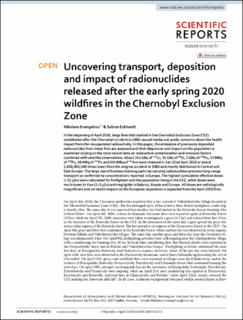Uncovering transport, deposition and impact of radionuclides released after the early spring 2020 wildfires in the Chernobyl Exclusion Zone
Peer reviewed, Journal article
Published version
Permanent lenke
https://hdl.handle.net/11250/2670701Utgivelsesdato
2020Metadata
Vis full innførselSamlinger
- Publikasjoner fra Cristin - NILU [1329]
- Vitenskapelige publikasjoner [1068]
Sammendrag
In the beginning of April 2020, large fires that started in the Chernobyl Exclusion Zone (CEZ) established after the Chernobyl accident in 1986 caused media and public concerns about the health impact from the resuspended radioactivity. In this paper, the emissions of previously deposited radionuclides from these fires are assessed and their dispersion and impact on the population is examined relying on the most recent data on radioactive contamination and emission factors combined with satellite observations. About 341 GBq of 137Cs, 51 GBq of 90Sr, 2 GBq of 238Pu, 33 MBq of 239Pu, 66 MBq of 240Pu and 504 MBq of 241Am were released in 1st–22nd April 2020 or about 1,000,000,000 times lower than the original accident in 1986 and mostly distributed in Central and East Europe. The large size of biomass burning particles carrying radionuclides prevents long-range transport as confirmed by concentrations reported in Europe. The highest cumulative effective doses (> 15 μSv) were calculated for firefighters and the population living in the CEZ, while doses were much lower in Kiev (2–5 μSv) and negligible in Belarus, Russia and Europe. All doses are radiologically insignificant and no health impact o

